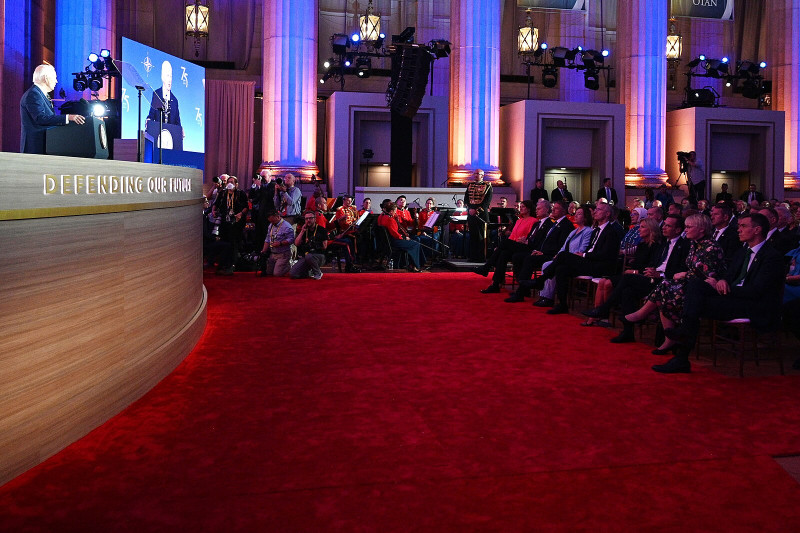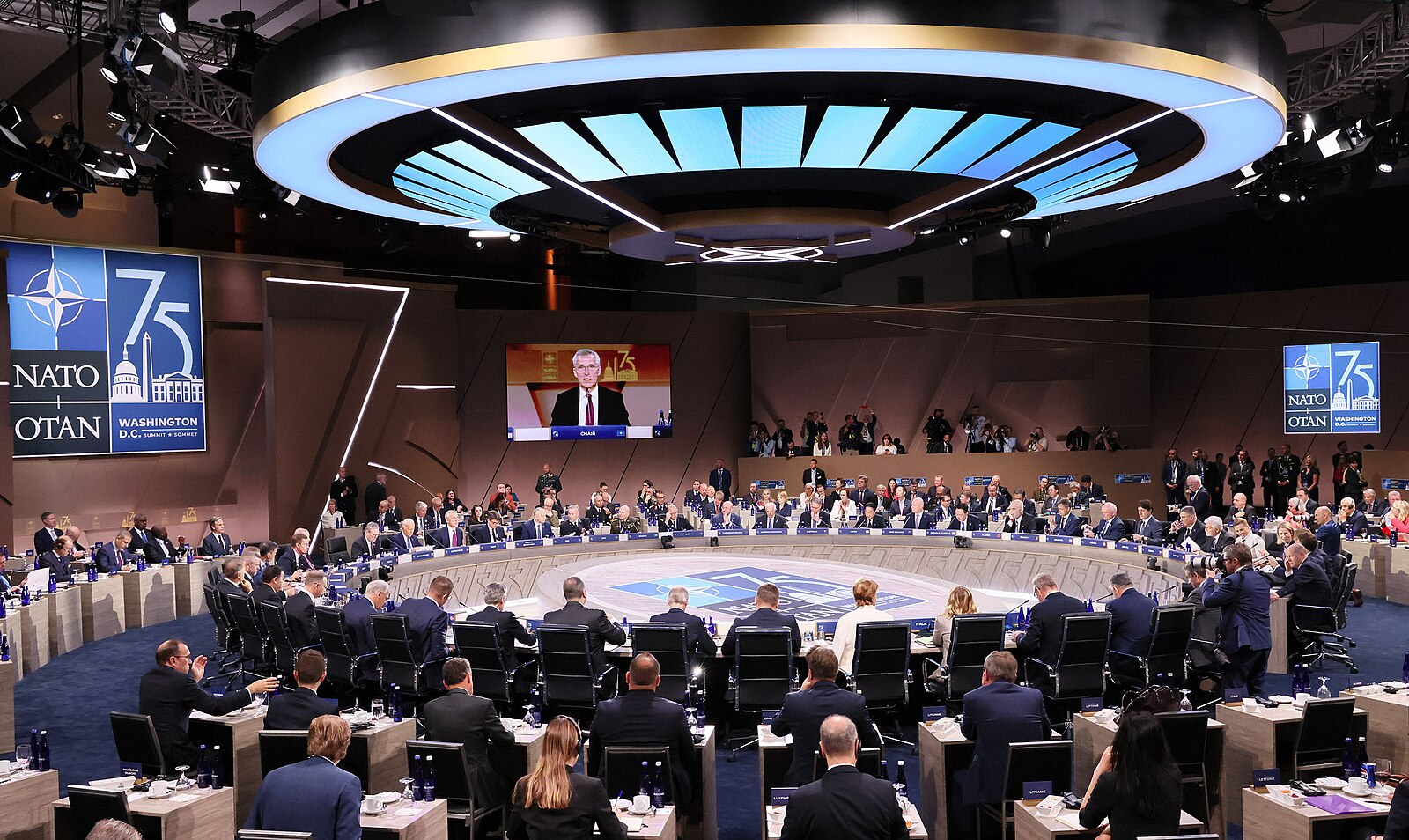Having operated for the longest as an alliance, seventy-five-year-old NATO has been capable of renewing itself, providing collective response to contemporary security threats and challenges. Yet, as both retiring NATO Secretary-General Jens Stoltenberg and summit host US President Joe Biden pointed out, passing this historical milestone was made possible by a series of allied decisions for commitment to the alliance at critical times. Today’s challenge is no different: the Washington Summit introduced new milestones in allied deterrence and defence, as well as enlargement and geopolitics.
Deterrence and Defence
In theory, NATO’s Washington Summit was an occasion to celebrate, not just because of the anniversary but also because of recent achievements. Since its foundation in 1949, the number of allies has grown from twelve to thirty-two, with the latest member (Sweden) concluding a more than two-hundred-year history in neutrality. Moreover, since Russia’s 2014 attack against Ukraine, the number of member states that spend above two percent of their GDP on defence has increased from three to twenty-three, with some members having even higher aims for the future.

The leaders at the Summit
Still, as the war in Ukraine wages on, NATO allies had little time to celebrate, and instead focused on furthering commitments for individual and collective defence. The crucial milestones in this regard are the regional defence plans. The reliability of these classified plans rests on allied capabilities. Accordingly, allies committed themselves to further modernize collective defence and provide “the necessary forces, capabilities, resources, and infrastructure” to the new defence plans.
Allied performance in arms production and procurement determines the ability in meeting the requirements of defence plans and providing security assistance to Ukraine. Hence the Washington Summit emphasized transatlantic defence industrial cooperation by adopting the NATO Industrial Capacity Expansion Pledge. Building on the Defence Production Action Plan of the 2023 Vilnius Summit, the pledge reflects hitherto and future allied efforts to strengthen their defence industries, increase investments and innovation in the defence sector, enhance compliance with NATO standards and interoperability, and deliver critical capabilities and defend defence-critical supply chains.
NATO allies also reinforced their commitment to resilience. Since 2014, and especially throughout the last few months, Russia has conducted hybrid warfare and sabotage on NATO territory. Such actions are under the threshold of Article 5, as Moscow does not intend to ignite an open conflict with the West yet. Nevertheless, these Russian efforts are violent in nature and are aimed to break allied resolve. Accordingly, the Washington Summit Declaration called for “increasing the Alliance’s collective awareness, preparedness and capacity across all hazards and in all domains”.
Long-term commitment to Ukraine
One of the core issues at this year’s NATO summit was the future of allied commitment to Ukraine. The Washington Summit confirmed previous statements that “Ukraine’s future is in NATO”, but more importantly, it called the country’s path to Euro-Atlantic integration “irreversible”. Allies held the second meeting of the NATO-Ukraine Council at the leaders level, and welcomed the Secretary General’s decision to appoint a NATO Senior Representative in Ukraine. The main expectation of the summit was of course the settlement of long-term security assistance against Russia’s invasion.
NATO’s support to Ukraine gained two important components in Washington. Firstly, the alliance approved a Pledge of Long-Term Security Assistance for Ukraine which is a commitment to provide military equipment, assistance, and training to Ukrainian forces so that they are capable of defeating Russian aggression. Since hitherto support was around EUR forty billion per year, the pledge aimed to provide a minimum baseline of the same amount by 2025. Secondly, allies decided to establish the NATO Security Assistance and Training for Ukraine (NSATU). The purpose of the NSATU is to coordinate the provision of military equipment and training for Ukraine “on an enduring footing, ensuring enhanced, predictable, and coherent support”. This will be done through a new, Seven-hundred allied personnel command centre in Wiesbaden (Germany), where the US has been running a three-hundred-personnel Security Assistance Group since 2022.
Perhaps the minimum baseline pledge and the NATO-ification of security assistance coordination were the most important expected deliverables of the summit. A war fatigue has gained traction across the West, particularly in the United States where the public sentiment is that further financial support for Ukraine depends on the outcome of this year’s presidential elections. Whether a second Trump administration would cease support to Ukraine is unknown, but the Biden administration and its European allies do prepare for such a development, hence the pledge for continued support coordinated by NATO.
Metrics of success
Overall, the Washington Summit was not just a self-celebratory gathering of heads of state and government, but a successful meeting with tangible deliverables. Nevertheless, there is still open questions for the not-too-distant future. Firstly, the alliance confirmed that China “has become a decisive enabler of Russia’s war against Ukraine”, and that Beijing “continues to pose systemic challenges to Euro-Atlantic security”. However, despite their call for a Chinese halt on material and political support to Moscow and for Beijing’s compliance with international rules and transparency in nuclear capabilities, the West remains divided over addressing China.
 President Joe Biden delivering his anniversary remarks at the Summit
President Joe Biden delivering his anniversary remarks at the Summit
Secondly, the NATO-ification of security assistance to Ukraine was a step toward predictability. However, even the allied pledge reflected the problem of disproportionate commitment among allies when it stated: “To support fair burden-sharing, Allies will aim to meet this pledge through proportional contributions, including by taking into account their share of Alliance GDP.” Moreover, minimum baseline funding is for the upcoming year (just like in the case of the recently approved USD 61 billion US aid package), reflecting the fact that neither Washington nor Brussels see—not that they could—the future of Ukraine’s support beyond 2025.
Lastly, the verdict over the summit’s success on leadership is still out. Jens Stoltenberg received well-earned praise for his decade-long service as Secretary-General, and Mark Rutte was successfully approved as his successor. At the same time, the summit was overshadowed by Joe Biden’s low approval rating after his notorious election debate with Donald Trump. As a proof of his ability to serve as Commander-in-Chief for a next term, the President delivered a fiery news conference after the summit. Still, whether the Washington Summit’s achievements can compensate his recent decline in support remains debatable.
The author is an American studies scholar, a fellow of the John Lukacs Institute for Strategy and Politics at the Ludovika University of Public Service, Budapest
Cover photo: Plenary of the NATO Summit with retiring NATO Secretary-General Jens Stoltenberg on the screen




